AMD Duron 650 Review
While Socket7 platforms were at the top of their popularity and both largest microprocessor manufacturers, Intel and AMD, produced CPUs for this socket, we were used to getting less efficient and cheaper solutions from AMD. However, a year ago the situation changed drastically. Having announced its Athlon, which could boast a better architecture than its primary competitor Intel Pentium III, AMD managed to take the lead in the CPU field for some time. And although later on Intel improved its processor core having added an integrated L2 cache, AMD still retained its position in the fast processors market. This situation has existed in the CPU market up to nowadays.
At present AMD tried to apply two means in the struggle against Intel. The first one was aggressive price policy, which made all Athlon processors much cheaper than their Intel Pentium III competitors working at the same frequency. And the second means was the core architecture, which allowed increasing the CPU working frequency somewhat easier than by Intel. As a result, AMD is now actively selling its 1GHz processors, while similar Intel Pentium III pieces are expected only by September.
But AMD is not free from problems. The major headache connected with Athlon processor is L2 cache implemented in the form of SRAM microchips, which used to be located on the processor board and were made by some third manufacturers. The youngest Athlon models had an L2 cache working at half the processor frequency, however, with the growth of the general working frequencies SRAM manufacturers couldn't keep pace with AMD and provide the required amount of cache microchips working at half the CPU frequency. So, starting from 750MHz, Athlon acquired cache memory working at 2/5 the CPU frequency and starting from 900MHz - at 1/3 the CPU frequency. All in all, the situation appeared quite paradoxical: 700MHz Athlon could boast the fastest L2 cache. Of course, AMD was pretty disappointed with that state of things, because slow L2 cache memory prevented the CPU performance from growing.
That is why they have finally made up their mind to move L2 cache of AMD Athlon processors from the external processor board into the CPU core, which seems quite logical, really. Especially, since both AMD factories, in Austin and in Dresden, shifted from 0.25 micron to 0.18 micron technology and hence could reduce the core size by 82sq.mm then.
As a result AMD Athlon family got a new life in new processors on Thunderbird core with a 128KB L1 cache and 256KB L2 integrated on-die cache working at the processor frequency. This newly born family of AMD Athlons supporting 750MHz and up was officially announced over 2 weeks ago.
But this was not the end. When they announced Athlon a year ago, we all heard that they would produce various modifications of their CPU intended for different market sectors. So, finally the company started putting its plans into life and announced a new AMD Duron family aimed at Low-End market sector and threatening the stable positions of Intel Celeron.
 
So, let's take a look at Duron features:
- Chip manufactured with 0.18 micron technology with copper interconnections
- Spitfire core based on Athlon architecture with 25 million transistors and 100sq.mm core size
- Works in specially designed mainboards for 462-pin Socket A
- High performance 100MHz EV6 system bus
- 128KB L1 cache (64KB for data and 64KB for instructions)
- 64KB L2 integrated on-die cache working at the full processor frequency
- 1.5V Vcore
- 3DNow! SIMD-instructions
- 600, 650, 700MHz versions available
So, considering its architecture, 64KB L2 integrated on-die cache appears the only difference between Duron and Athlon CPUs. Nothing more other than that. If we compare the new Duron with new Athlon processors on Thunderbird core the difference will lie in the size of the integrated on-die L2 cache (256KB by Thunderbird against 64KB by Duron) and in the working frequencies (Thunderbird CPUs support frequencies starting from 750MHz and Durons - up to 700MHz). Again: no more differences.
However, you should still bear in mind that Duron and Thunderbird have a new and technologically enhanced core manufactured with 0.18 micron. As a result, Duron core with the integrated on-die L2 cache appears even smaller than K75 core (0.18 micron Athlon).
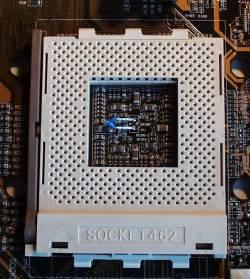 We would also like to touch upon a new form-factor and processor socket, which is now used in AMD CPUs. Since new Duron and Thunderbird processors don't have any external L2 cache and hence don't require any SRAM microchips, AMD followed in Intel's footsteps and paid attention to processor socket. It was not only more profitable from the commercial point of view (no need in the processor board, cartridge, etc.) but also guaranteed a much more efficient cooling. For this socket AMD selected a 462-pin Socket A, which looked very much like Socket7 and Socket370 and was practically of the same size. That is why you can use old Socket7 and Socket370 coolers together with Socket A AMD processors. The only thing you should keep in mind is the heat dissipation, which is a bit higher in case of Duron CPU compared to Celeron that is why Durons need a better cooling. For example, Duron 650 dissipates almost the same amount of heat as Intel Pentium III 733. We would also like to touch upon a new form-factor and processor socket, which is now used in AMD CPUs. Since new Duron and Thunderbird processors don't have any external L2 cache and hence don't require any SRAM microchips, AMD followed in Intel's footsteps and paid attention to processor socket. It was not only more profitable from the commercial point of view (no need in the processor board, cartridge, etc.) but also guaranteed a much more efficient cooling. For this socket AMD selected a 462-pin Socket A, which looked very much like Socket7 and Socket370 and was practically of the same size. That is why you can use old Socket7 and Socket370 coolers together with Socket A AMD processors. The only thing you should keep in mind is the heat dissipation, which is a bit higher in case of Duron CPU compared to Celeron that is why Durons need a better cooling. For example, Duron 650 dissipates almost the same amount of heat as Intel Pentium III 733.
The youngest 600MHz Duron model costs about the same as the eldest 600MHz Intel Celeron processor, which is close to $112 in supplies exceeding 1000 pieces. AMD is most likely to aim at the cost of Celeron and will keep the parity with the competing products. In fact, it is quite logical remembering that both processor families, AMD Duron and Intel Celeron, are intended for one and the same group of customers.
Now let's try to compare the major peculiarities of both competing products aimed at sub-$700 PCs. The first thing we would like to point out is a different manufacturers' approach towards the development of low-cost CPUs. Intel Celeron is none other but a light version of Intel Pentium III with a half of L2 cache being disabled and a system bus slowed down. AMD Duron looks much more attractive from this viewpoint: it is not lighter and not slower. Duron uses its own core different from the core of an elder model, Thunderbird. We don't know what it means for us, users. Intel reduces the manufacturing expenses by making its product mass and AMD - by giving it a smaller core.
In our Intel Celeron 566 Review we wrote that the main problem about this processor was the system bus frequency - 66MHz. That's true, the today's CPU working frequencies are so high that the system bus bandwidth of 528MB/sec is evidently not enough. As for AMD Duron, it doesn't have any problems with the system bus. Since this CPU, as well as all the rest from Athlon family, uses 100MHz DDR EV6 bus. So, the bandwidth of this system bus turns out 1.6GB/sec, which is three times as high as by Celeron.
L1 cache in Duron hasn't been changed since the epoch of the first Athlon CPUs. It is 128KB, which is four times as large as that by Celeron. Like L1 cache of Celeron processor, L1 cache by Duron is also divided into two parts: one part for caching the data and the other - for instructions.
As far as L2 cache is concerned, AMD prepared us a small surprise. You can easily notice that it is twice as little as L1 cache. What is the use of such a small cache then? Well, if you take a look at the algorithm of Duron L2 cache (and of Thunderbird's, as well), you will find an answer to this question. L2 cache of these processors is exclusive, which means that the data stored in L1 cache isn't duplicated in L2 cache. This method has been now implemented only in new AMD processors. All Intel CPUs have an inclusive L2 cache, which duplicates the data stored in L1 cache. That is why the overall size of the effective cache memory by AMD Duron makes 128+64=192KB, while by Celeron it makes only 128KB (32KB of L2 cache are occupied by the data copy from L1 cache).
As you see, a new Low-End CPU from AMD managed to surpass Intel Celeron almost everywhere. However, even the Sun is not spotless. Like by Athlon with an external L2 cache, the faster cache by Duron and Thunderbird is connected to the processor core by an old 64bit data path. Unfortunately, AMD engineers seem to have been quite lazy when they were moving the cache into the processor core, because they didn't care to change its connection to the core as well. Celeron or Pentium III on Coppermine look much more attractive from this point of view, due to the Advanced Transfer Cache, which includes a 256bit L2 cache data path. That is why in case of a relatively high workload at high working frequencies the cache in new AMD processors may appear quite slow.
In order to illustrate all the things mentioned above, we would like to offer you a chart, which show the data write speed of different data segments for Intel Celeron 667 and AMD Duron 650 processors:

Intel Celeron 667
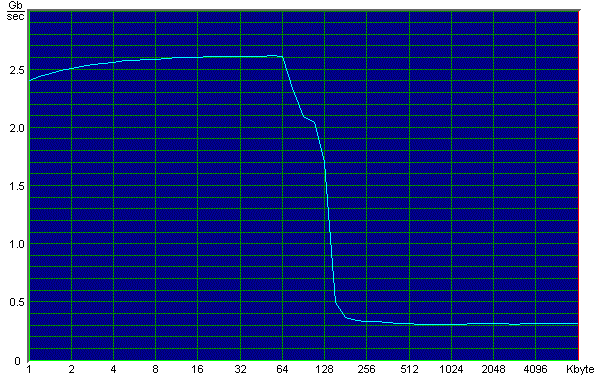
AMD Duron 650
So, you can clearly see that the data sector in Duron's L1 cache is larger than the corresponding sector in Celeron. Duron's L2 cache remains practically unnoticeable against the background of the huge L1 cache. And which is really noticeable, it's higher memory working frequency of Duron CPU. Nothing to be surprised at, actually. Celeron fails to catch up with its competitor because of its 66MHz bus with a very low bandwidth.
Well, enough for theory, let's turn to practice. The test system was configured as follows:
- AMD Athlon 600, 650 and 700 CPUs; Intel Pentium III 600EB, 667 and 733 CPUs; Intel Celeron 667 CPU; AMD Duron 650 CPU;
- Chaintech 6ATA4, ASUS K7V and Gigabyte 7ZM mainboards;
- 128MB PC133 SDRAM by Micron;
- Creative 3D Blaster Annihilator Pro graphics card;
- IBM DJNA-372200 HDD;
- Creative SoundBlaster Live! sound card.
We tested all the CPUs on VIA chipsets based mainboards on purpose. These were: VIA Apollo Pro133A, VIA KX133, VIA KT133. We did it because all these chipsets have similar cores and so we can compare the processors avoiding the influence of the chipset implementation.
Before passing over to the practical results obtained during the tests, we would like to say a few words about Socket A mainboard, which we used in our testbed for AMD Duron processor. Today AMD recommends only four Socket A mainboards for use with their CPU: Biostar M7VKA, FIC AZ-11, Gigabyte GA-7ZM and Microstar MS-6340. We managed to get one of them, Gigabyte 7ZM. This mainboard is made in MicroATX form-factor and is based on VIA Apollo KT133 chipset. It features 3 DIMM slots, 3 PCI slots, 1 AMR and 1 AGP slot. CPU can be configured on this mainboard with the help of a set of dip-switches, which allow setting the following FSB frequencies: 95, 100, 105, 110, 113, 115, 117 and 133MHz. The integrated sound on Gigabyte 7ZM is based on AC'97 software codec. The mainboard uses AMI BIOS.
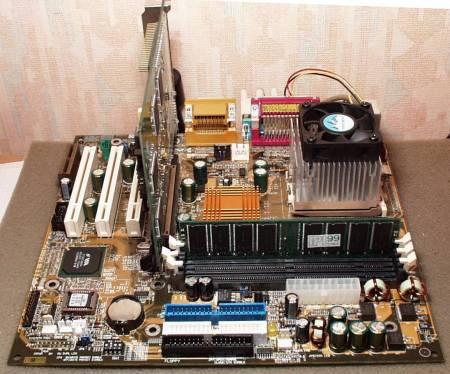
So, let's get started. First we will look at the performance according to synthetic benchmarks and then we will continue with the real life applications.
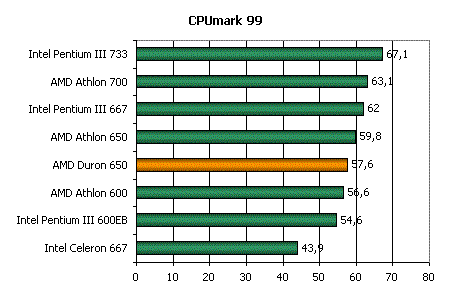
This test shows the integer performance of the CPU and the data transfer rate. As you can see, Duron 650 feels quite at home here. Its performance is somewhere near Intel Pentium III 600EB and AMD Athlon 600. This is a considerably good result for a Low-End processor. Look, for instance, at the results obtained with Celeron 667. It suffers a total fiasco compared with Duron. Here you should address your thanks to Intel, which provided its value CPU with a real brake: 66MHz FSB.
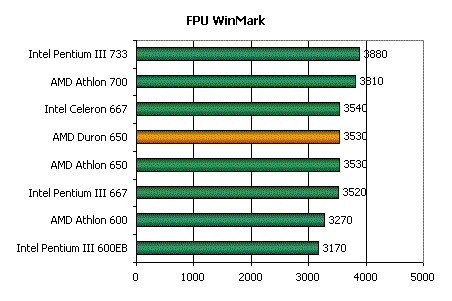
This benchmark shows the performance in floating point operations. The results obtained prove once again that new Duron core is the same as by the old Athlon CPU. Working at the same frequency both processors perform equally. By the way, since all the required data for the FPU WinMark fit into L1 cache of all the CPUs tested, Celeron shows really impressive results. Well, now we've got one more explanation of Celeron's slow performance in real applications: it is situated beyond the processor core.
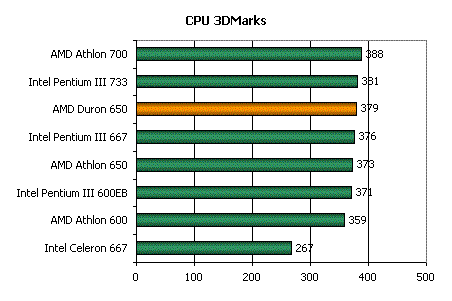
The next benchmark included into 3Dmark2000 presents the theoretical CPU performance in case of typical 3D-scenes processing using SSE SIMD-instructions and 3DNow!. Well, the fact that AMD devoted some time to 3DNow! implementation in Athlon processors still has a positive effect on the performance. As you can see, only Intel Pentium III 733 can compete with Duron 650. As for Celeron, we have to state that it failed in this test despite the Coppermine core and SSE technology support.
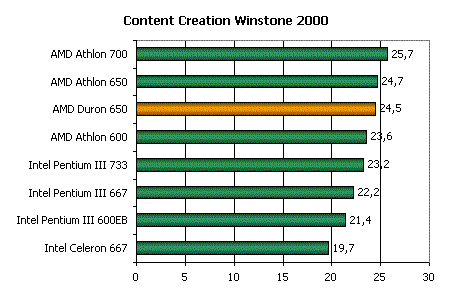
Now let's take a look at the real applications. According to Content Creation Winstone 2000, AMD processors are slightly ahead of their Intel competitors. So, Duron 650 turns out even faster than Intel Pentium III 733. As far as all other AMD processors are concerned, Duron is just a bit (2-3%) slower than the ordinary Athlon working at the same frequency. Of course, this is a very nice thing for those of us, who wish they could get a bit more for a bit less money. However, we are really very curious to find out how AMD will sell their old Athlon processors later on...

This test is also based on office applications. However, the tasks for SYSmark 2000 are selected in such a way that Intel CPUs appear better. There are two reasons for that: better support of SSE instructions by the applications and better implementation of L2 cache algorithms in Intel processors. As for our today's hero, Duron 650, it performed even worse than Intel Pentium III 600. You can notice that we simply have to compare Duron with Pentium III, because its competitor No1, Celeron, proved just uncompetitive. See yourself: Intel Celeron 667 falls behind AMD Duron 650 by over 12%!
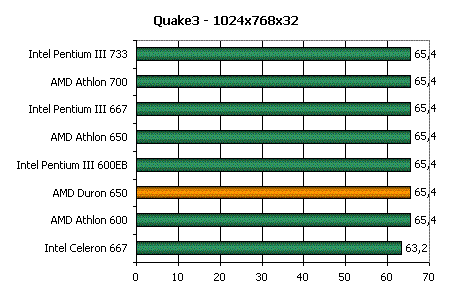
Now let's consider AMD Duron performance in games. As we have already mentioned, the fps rate at higher resolutions in Quake3 depends mostly on the memory bus and AGP frequency. Our case is also not an exception. That is why AMD Duron and AMD Athlon and Intel Pentium III perform on the same level here. And Celeron lags behind everybody. No wonder, since its 66MHz FSB can't ensure the bandwidth, which could meet the requirements of the today's applications.
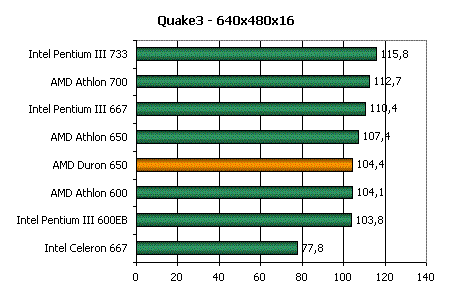
The results obtained in Fast mode are a very good benchmark. Duron 650 proves very close to AMD Athlon 600, which is 4% lower than by Athlon 650MHz. Intel Celeron 667 falls behind AMD Duron 650 quite greatly: it is nearly 35% behind. If both of these processors cost almost the same, Duron doesn't leave a single chance to Celeron.
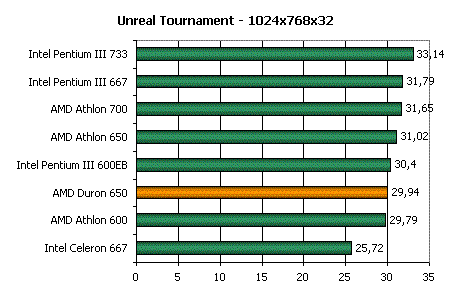
Again AMD Duron appears only 3% slower than Athlon supporting the same frequency. However, here it is also a bit behind Intel Pentium III 600EB.
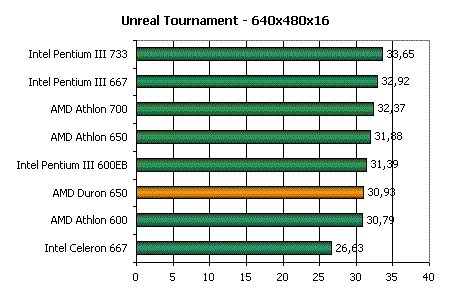
The situation is again very similar to what we have already seen. Again Celeron 667 is far behind: the gap makes nearly 16%.
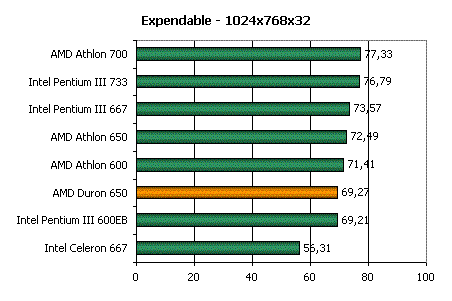
Expendable is a game processing large data arrays. That is why large L2 cache means quite a lot here. This explains the defeat of AMD Duron 650, which is a bit behind AMD Athlon 600 and performs like Intel Pentium III 600EB. As for Celeron 667, it is 25% far away here.
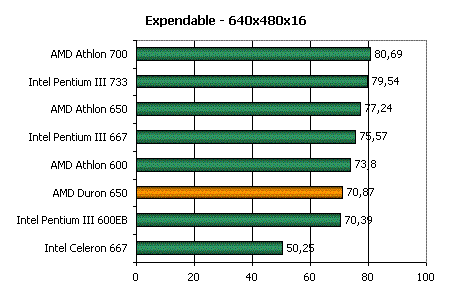
At lower resolutions the results in Expendable are very similar to the previous chart. The only thing worth mentioning here is a worse performance of Celeron 667.
In conclusion we would like to say a few words about overclocking. We have already mentioned in
one of our latest articles that Intel Celeron is a very overclockable CPU. For instance, Celeron 667 can be overclocked to 1GHz. It allows combating one of the major factors limiting the CPU performance: the processor bus. And what about Duron?
Like many other modern processors, Duron features a locked multiplier. Although some mainboards are rumored to be overcoming this limitation, solutions like that are still unavailable nowadays. That is why the only way to overclock AMD Duron today is to increase the FSB frequency. However, EV6 system bus used in Socket A systems is not very overclocking friendly. The data is transferred along this bus at 200MHz and even the slightest frequency increase can result into system stability worsening. So, when testing our Duron 650 processor we managed to increase the FSB frequency only by 10%, which makes 110MHz. All other attempts ended up in failure because the system either turned very unstable or crashed when booting.
So, if you count on overclocking your system, then the best solution for you today still remains Intel Celeron, which sometimes allows overclocking by 50% and up. But a bit more time will pass and the situation will undoubtedly change, and it is very likely to happen not in Celeron's favour. The thing is that it appeared possible to cope with the locked clock multiplier by Duron. We have to admit that this is not the easiest method and requires a bit more effort from the mainboard manufacturers, such as more BIOS programming. However, a couple of mainboard manufacturers with a very experienced developer team, such as ASUS and QDI, managed to implement this algorithm in their Socket A products. And all we can do now is just to wait for ASUS A7V and QDI K7T to appear in the market.
Unfortunately, we should also point out that it is still very hard to buy a Socket A mainboard. We can only hope for the better: the situation with Athlons when the amount of AMD CPUs was much greater than the available mainboards, shouldn't repeat.
Conclusions
AMD did a great job. Its new CPU is a success. Its shows performance cool enough not only to surpass Intel Celeron but also to give it no chance at the nominal frequencies. AMD Duron 650 proves just a few percents slower than AMD Athlon 650 and very close to Intel Pentium III 600EB. So, if Intel doesn't undertake anything to increase the performance of its Low-End CPU, AMD Duron will bring the epoch of Celeron to an inevitable end.
That is why now we should probably get ready to see Celeron processors with a 100MHz bus. At least this seems to be the easiest way-out for Intel.
And bearing in mind the possibility to free the locked multiplier in AMD Duron, Celeron processors have every chance to lose overclockers' preferences. To our great disappointment we didn't have any mainboards at our disposal, which could allow checking Duron overclocking potential to the full extent, however, we really hope to get back to this interesting topic very soon.
|